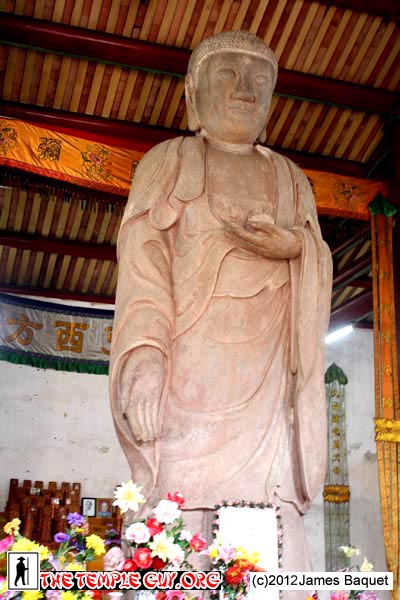(1) This is the gate to the grounds of Nanshan Temple in Zhangzhou, Fujian, which faces east; the temple faces north because (I suspect) it used to be located on the river. See the Google Map; zoom out to see the river. The "pond" looks like the remains of an old river channel, with the broader, modern river north of it.
(2) This is one of the dragons on the front wall (seen on the right in the previous picture). Someone figured out that the gap behind his tail could be used as an incense holder; see the bristle of red sticks?
(3) The roadway in from the gate. The water is on the right. The monk on the right is walking slowly along the curb; I saw others doing it, too, and suspect it may be a kind of walking meditation. This one made the trip several times while I was there!
(4) As you walk along the entry road, with the pond/river-remnant on the right, this dilapidated old City God temple appears on the left.
(5) The sign in front of the stagnant water says "free-life pond."
(6) Although the water is stinky, this double row of palms between the water and the roadway was beautiful.
(7) Inside the temple, I noticed the ceilings were magnificent. This one is in a corridor around the courtyard between the Mountain Gate and the Heavenly Kings' Hall.
(8) And this one is over one of the Heavenly Kings.
(9) The main compound is lined on either side with hundreds of feet of carved wooden reliefs. It looked like there were different subjects in different panels, not all "one story."
(10) Here's a detail of one of the reliefs.
(11) And here's a detail of another relief.
(12) The front of the Main Hall.
(13) Looking back across the courtyard from a corner of the Main Hall, you see these candles set up as a swastika, waiting for the hoards of New Year's visitors.
(14) A detail of the ornate carving on the front of the Main Hall.
(15) The Buddhas in the Main Hall were pretty, but not spectacular. By the way, I'm not entirely sure yet who the flanking Buddhas are; the usual Medicine Buddha and Amitabha were against the back wall.
(16) But the Bodhisattva figures behind the Buddha wall in the Main Hall were gorgeous. Puxian to the left (our foreground), Guanyin in the center, and Wenshu to the right, all against a cloudy-blue-sky wall. Impressive.
(17) In a small side courtyard was the "Clean Cause" (jingye 净业 = "Pure Effort"?) Hall. It's just behind the ancient monk.
(18) Inside the "Clean Cause" Hall are these three figures (probably sandstone?) of the "Three Sages of the West," Dashizhi to the left, Amitofo in the center, and Guanyin on the right.
(19) A closer look at the central Amitofo of the "Three Sages of the West" in the "Clean Cause" Hall.
(20) On the opposite side of the courtyard is the pleasant-looking Dizang.
(21) On a platform behind the Main Hall is a good-sized Dharma Hall flanked by two smaller halls. I liked the paint on the front of the one on the left.
(22) The small hall on the left behind the Main Hall contains an image of Chen Yong, who (due to political machinations) converted his home into this temple back in the Tang Dynasty. All he got in return was this statue.
(23) There were numerous photos and drawings of "dharma ancestors" inside the Patriarch's Hall, the small building to the right behind the Main Hall. I'm dying to know who they all are!
(24) I left the temple and walked out to where the bus stops are, seeing quite a few homey sights along the way (and saving a little over a US dollar by taking the bus instead of a taxi back to the long-distance bus station). One thing I saw was this tiny, shiny-new-looking folk temple near the Buddhist temple's grounds. It's called "Twin Nunnery Temple" (Shuang-an Miao--双庵庙). By the way, the area south of the main temple is occupied by the "Zhangzhou Martyrs' Cemetery," and this is near one gate.
(25) I've seen monks in cars, and on scooters and bicycles, but this was the first time I saw one on a tricycle! A fitting close to the day.
| ← Previous Site | Back to Trip 14 Introduction | Next Site → |
Last Updated August 11, 2019


























No comments:
Post a Comment